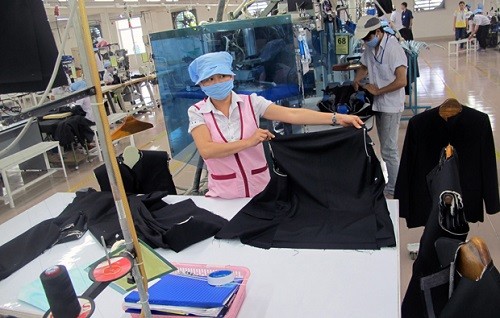(VOVworld) – Vietnam is entering the final negotiation rounds to become a member of the Trans-Pacific Partnership (TPP), a free trade agreement among Asia-Pacific economies. Joining the TPP will create both opportunities and challenges for Vietnam’s investment, exports, and international integration process.
 |
| Vietnamese garment and textile industry is likely to benefit most from TPP. In the photo: workers at the 29 March Textiles and Garments Company (Photo: baodanang.vn) |
The TPP agreement will link the most important economies in Asia - Pacific with 792 million people contributing nearly 40% of the world’s GDP and one third of the global trade value. To date, 12 countries have been involved in TPP in negotiations, including the US, Canada, Mexico, Australia, and Chile. Most recently Japan joined the negotiations widening the TPP’s impact.
TPP negotiators have so far agreed on most key issues, including intellectual property rights, epidemiology, services, investment, and technical barriers in trade, telecommunications, and e-commerce. The highlight of the agreement is healthy trade competition in which import tariffs will be completely abrogated.
Once Vietnam, a developing country, joins the agreement, it will create great opportunities for Vietnam’s production, business, trade, and investment for socio-economic development. Doctor Vo Tri Thanh, Deputy Director of the Central Institute for Economic Management, says:
“The TPP agreement will benefit Vietnam’s exports especially in areas where Vietnam enjoys advantages like garments and textiles, services, and investment. Additionally, Vietnam will have more chances to work with large partners and markets not only in capital but also in technology potential which will help Vietnam grow. The process of becoming a TPP member has forced Vietnam to hasten its reforms and change its economic growth model to meet TPP requirements.”
The signing of the TPP is expected to boost the Vietnamese garment and textile industry, one of the country’s economic spearheads. Last year, the sector earned more than 15 billion USD from exports. The US buys half of Vietnam’s exports but the import duties in this market are relatively high, 17.5% on average. When the TPP is signed, the tariff will be 0%.
The TPP will also create new opportunities to attract investment, and new possibilities of joint ventures between domestic and foreign businesses to lure production capital, particularly for developing auxiliary industries.
Institutionally, TPP will offer a more transparent business environment as it’s based on equality of state-owned enterprises, private companies, and foreign businesses.
Along with opportunities, the TPP is likely to create challenges for Vietnam. The biggest challenge will be improving legislation and law enforcement to create a level-playing-field business environment. A second challenge will be helping enterprises figure out how to approach the TPP. Businesses must be prepared to adapt to competitive pressure because after Vietnam joins the TPP there will no longer be any tariff barriers. Nguyen Thu Trang, Director of the WTO Center of the Vietnam Chamber of Commerce and Industry, says:
“Many enterprises will find that the TPP creates new export opportunities as exports will enjoy preferential duties of 0%. But in order to get the special treatment, businesses must satisfy requirements such as certifying the origin of goods which will require Vietnamese enterprises to change their ways they produce, transport, and purchase materials. This change will not happen overnight. Domestic companies should improve their capacity in all areas if they want to make the most of the TPP’s advantages.”
Since November 2010, Vietnam has completed 18 rounds of TPP negotiations and is approaching the signing. But Vietnam should be prepared for an environment in which there are no special mechanisms for economies at different development levels.